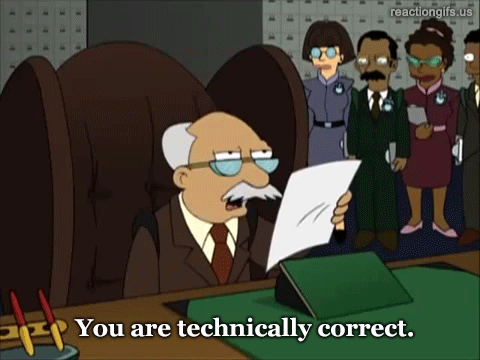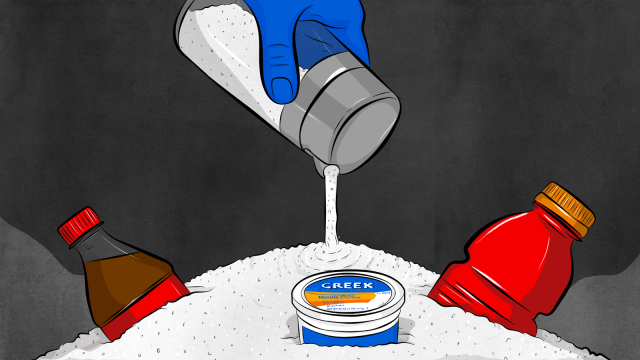While Australia doesn’t list added sugars on food labels, perhaps it should. Added sugars will be required on new labels rolling out in the US in a year or two. A 570g Pepsi will have to say it contains 130 per cent of your daily value of added sugar. Yogurt will have to call out their added sugar, so people can’t kid themselves that it all comes from fruit. Food companies fought the change, but they lost.
Yes, sugar industry, you are right: Added sugars are made of the same stuff as natural sugars. But the FDA’s new labels are about health, not about getting the right answer on a chemistry quiz. It’s really useful to know which foods contain a ton of added sugars.
Illustration by Sam Woolley.

Sugar Is Just Empty Kilojoules, But That’s the Whole Problem
“Sugar is sugar, regardless of its source, and it’s treated the same way by the body whether you add a spoonful of it to your coffee or drink a glass of juice,” the American Beverage Association wrote last year, when there was still some chance the FDA might change their mind. This is true: Sugar is sugar, whether it comes from sugar cane or corn syrup or a homegrown strawberry.
Other industry groups rallied around this quibble to fight the “added sugars” label — the Sugar Association and the American Bakers Association, to name just a few. They also complained that consumers might have trouble understanding the labels, that the difference would be impossible to enforce, that Europe doesn’t label added sugars and a million other points that don’t really matter. The FDA, in response, produced an epic smackdown of a document that addresses these concerns, point by point.
To the lack of a direct link between sugar (versus other kilojoules) and obesity:
We are not establishing or relying on a direct link to obesity from added sugars intake for the general population. There is adequate evidence that the U.S. population consumes excess calories from added sugars, above the discretionary calories permitted within a recommended caloric intake.
In other words, they’re not saying sugar is evil, just that it’s empty kilojoules. They go on to say that if you’re trying to eat 8368kJ (2000 calories), it’s pretty much impossible to get enough healthy, nutrient-dense food when you’re spending more than 837 of those kilojoules (200 calories) on pure sugar.
In a twist on the industry’s beloved “sugar can be part of a healthy diet” message, the FDA concludes:
Thus, by requiring the added sugars declaration on the Nutrition Facts label, we will give consumers a tool they need to include added sugars as part of a healthy dietary pattern.
So, added sugars aren’t single-handedly responsible for making us gain weight or get sick. But if we can avoid added sugars, we’ll be able to eat healthier overall.
Labelling Added Sugars Shows What Food Companies Are Doing
The sugar in a Coke is no secret: It’s all there for taste. But in many products, we may not realise how much sugar is added just to make things sweet and tasty. Even if we flip a package over to see the amount of total sugar, it’s hard to know if that’s “too much” sugar.
The Dietary Guidelines released earlier this year (by the USDA and HHS, no relation to the FDA) finally set a limit on added sugars. So now we know how much is too much: If a strawberry yogurt has 39 per cent of our daily added sugar, well, that’s a lot.
Here’s how you can get a sneak peek on those added sugar values. The USDA’s SuperTracker has a database of foods, and their information includes the number of calories from added sugar. Just divide by 200 calories — or, as a shortcut, halve the number of calories and that gives you the per cent. So, 78 calories (326kJ) from added sugar means 39 per cent of the daily value. Here are a few examples:
- A packet of cinnamon and spice instant oatmeal: 21 per cent
- One cup of All-Bran Bran Buds cereal: 44 per cent
- A bottle of Gatorade: 61 per cent
- A medium fast food shake: 72 per cent
- A large blueberry muffin: 75 per cent
Sugary foods are scattered all over the supermarket. According to a recent study published in the Lancet, around 60 per cent of packaged foods contain some amount of added sugar — maybe a little, maybe a lot. You can spot them in the ingredient list, but not every form of sugar is obvious. Agave sweetener and brown rice syrup are among the lesser-known sugar sources.
The Battle Over Added Sugars (And Health) Is Evolving
Of course, now that the US knows what’s up, manufacturers will probably start changing their products, which may also affect any American foods that are imported to Australia. One of the industry’s talking points in opposition to the proposed sugar labelling was that it would cost a lot to reformulate products once people catch on to how much sugar they are actually eating. Perhaps they mean they will make products less sweet, but they’re probably also looking for sneakier sources of sweetness.
The FDA chose to count 100 per cent juice as only containing natural sugars, so a bottle of juice — whether from concentrate or not — will contribute zero per cent of your daily value for added sugars. (The World Health Organisation disagrees, defining “free sugars” to include juice). That said, fruit juice concentrates are now considered a sweetener if they’re not diluted back to their original strength. That would seem to eliminate the most obvious loophole, but don’t underestimate human creativity.
For example, just this May, General Mills was granted a patent for a yogurt-based food additive, which it notes “can be utilised as a… sweetening agent.” The FDA decided to exempt dairy-derived additives from the definition of added sugars.
Because natural and added sugars are chemically the same, there’s an additional problem: It’s not easy to test whether a company is following the rules by analysing a food product. The FDA says that companies will have to keep records to track how much added sugars they use. Laboratory techniques do exist that can tell the difference between corn, cane and beet sugars (the main sources of added sugar in the US), but they’re not in common use. Will food companies cheat? We’ll have to wait and see.

Comments
4 responses to “Why You Should Care About Added Sugars In Your Food”
“While Australia doesn’t list added sugars on food labels,…”
Huh? I thought it did, and a government web site seems to think so too.
From the eatforhealth.gov.au web site:
“You can use this to spot foods that might be high in saturated fat, added salt or added sugars because these ingredients are listed in the top three.”
Australian labelling laws currently do not require manufacturers to distinguish between added and natural sugar. If you take a look at an Australian food label (there’s an example on the page you cited) you’ll notice that ‘sugar’ is all lumped into one category.
Added sugar may be found in the ingredients list, if you know where to look and the various alternate names for it, but it is not stated on the label.
“Because natural and added sugars are chemically the same”
No. Sugars from various sources are most definitely NOT the same.
Put simply (ignoring complex carbs), “natural” sugars will be monosaccharides whilst refined sugars – which include table sugar and “added” sugar in our food – are typically high in sucrose which is a disaccharide. The way the body deals with these is different. Yes, you guessed it, sucrose is worse for you and this is the reason the food companies don’t want to list added sugars separately.
Is High Fructose Corn Syrup considered an ‘added sugar’ for the purpose of this labeling? Because most US stuff is loaded with that shit instead of sugar, and it’s even worse for you than sucrose is.